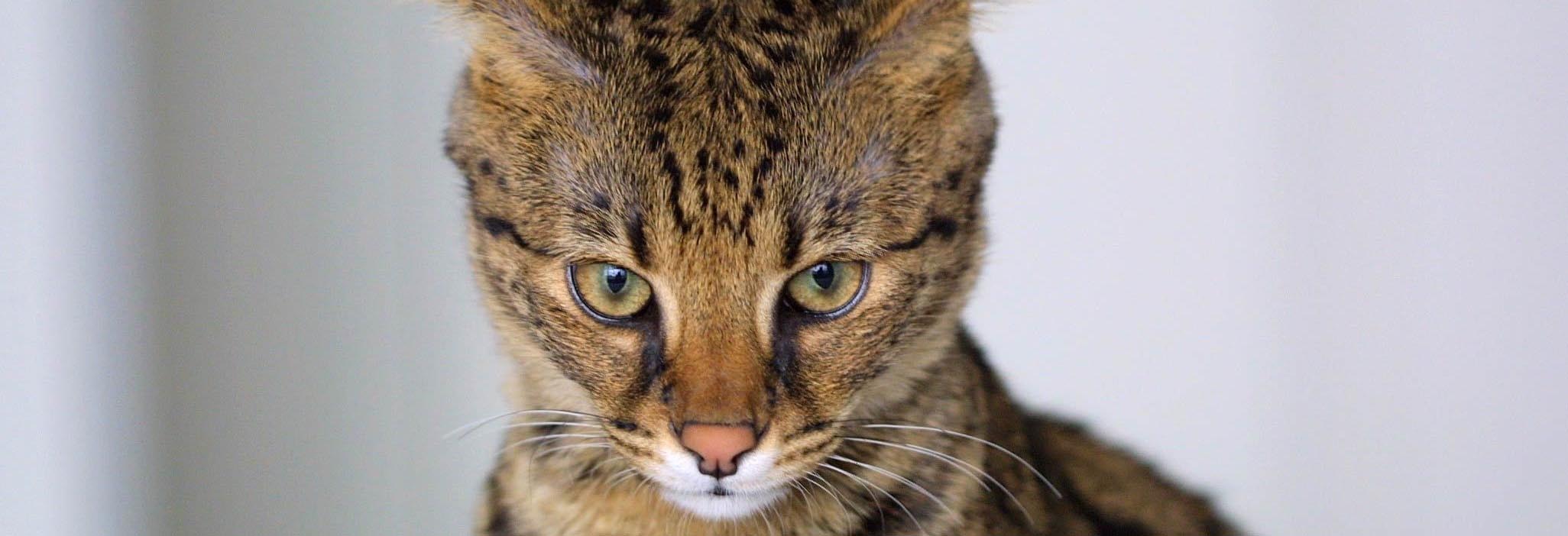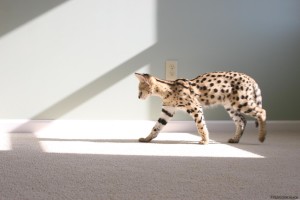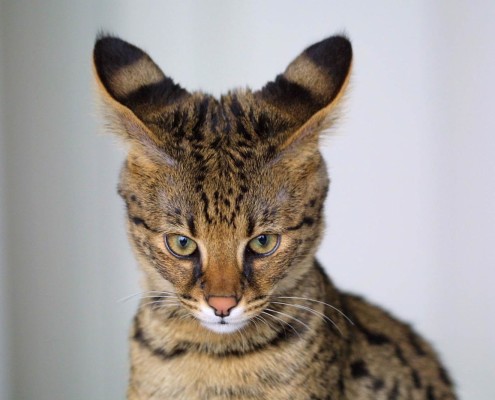Savannah

Meoww!!
The Savannah is a very graceful, uniquely built cat, with a lovely long neck, long legs and ears, and a three-quarter length tail.
In 5 Words
- Extemely intelligent
- Highly curious
- Active
- Loyal
- Affectionate
Snapshot
Size: medium
Weight: 15 to 28 pounds
Origin: United States of America
Life Span: 20 year lifespan
Colour: brown-spotted tabby (cool to warm brown, tan or gold with black or dark brown spots), silver-spotted tabby (silver coat with black or dark grey spots), black (black with black spots), and black smoke (black-tipped silver with black spots) only.

Characteristics
Learn About the Savannah
The Savannah Cats were originally bred back in the 1980′s by a woman named Judee Frank. Since then breeders have embraced her vision and have worked to get fertile generations of males to be used with the early generation Savannah females. Over the last couple years this dream has been realized. Many breeders including Marechal Cattery are now using fertile male Savannahs in their programs to create even more exotic looking offspring. This was a long process of breeding with feline outcrosses to finally reach the distance needed from the Serval cat to have males that were actually fertile. So far there have been a very small amount of fourth generation males that are fertile with most males having to be fifth or later generations to be fertile. As we breed back to our Savannah females using the fertile Savannah males we will begin to set the type of the breed which is, large ears, long lean legs and bodies and large dark spots.
The first known Savannah was born April 7, 1986 when a female domestic cat gave birth to a kitten sired by an African Serval. This F1 (first generation hybrid cross) was the first on record. This unusual female kitten had both domestic and Serval like traits. Both the kitten and breed were named “Savannah”. Patrick Kelly heard about Savannah and decided he wanted to try to develop a new breed. He persuaded a breeder, Joyce Sroufe, to join him in his efforts. Together they wrote the original TICA Breed Standard.
In 1996, Patrick Kelley and Joyce Sroufe wrote the original version of the Savannah breed standard, and presented it to the board of (The International Cat Association). In 2001, the board accepted the breed for registration.
The Savannah is a very graceful, uniquely built cat, with a lovely long neck, long legs and ears, and a three-quarter length tail.The head is longer than wide, and they have a long slender neck. The back of each ear has a light band bordered by black stripes, which are called ocelli. The short tail has black rings, with a solid black tip that extends several inches. The eyes are blue as a kitten, and usually green as an adult. Black “tear-streak” markings run from the corner of the eyes down the sides of the nose to the whiskers, much like a Cheetah’s.
The black tear marks help reduce glare from sunlight, which aid the Savannah’s vision during hunting. Savannah cats typically grow to weigh 25-30 pounds, which makes them as large as many domestic dogs, if not larger.Their slim build gives them the appearance of even greater size.
Average size is also very dependent on generation and sex, with F1 male cats usually being the largest. The Savannah can have a tan coat with black or brownish spots, or a silver coat with dark spots, a marble (also called classic) pattern, and many other patterns and colors, although The International Cat Association (TICA) breed standard calls for black, brown spotted tabby, silver spotted tabby and black smoke types only.
The Savannah is an intelligent and highly curious cat, a combination which results in the cat frequently opening doors, drawers and cabinets. Savannahs are more social than typical cats and are commonly compared to dogs in their loyalty. They will follow their owners around the house like a canine. Savannah Cats are unlike any other breed. They are often described as being very ‘dog like’ in behavior. They are very outgoing and active, loyal, and get along well with both children and dogs. They are easily leash trained and often do very well with clicker training.
They show their affection by giving a “head-butt” where they literally bump heads with you. They are also extemely intelligent and curious. They quickly learn to open doors and cabinets and make a game of finding the hiding place of their favorite treats. Another unique trait of the Savannah is their love of water. They find great delight in splashing in their water bowl or in the tub. All Savannahs have very high energy levels and are extremely curious and playful. This very active cat is curious, assertive, and an adventure-seeker. It requires a lot of interaction and attention on a daily basis, either with its companion human(s) or other companion cats. This cat is also very loyal, and will develop a strong bond with people.
They will follow their owners around the house like a curious little puppy. They can also be trained to walk on a leash and play fetch, and many Savannahs love to play in water. A Savannah expects to be a family member that is involved in every activity rather than being just a usual house pet. They are not typical “lap cats” as they are very active and large, however they do love to be petted, and will show their affection for their humans through head-butting and kissing (licking).
There is some evidence that Savannahs and other domestic hybrids (e.g. Bengals) don’t respond well to anesthesia containing Ketamine. Because it’s uncertain what effects may arise, it is not recommended to use anesthesia containing Ketamine for any surgeries done to a Savannah. Isoflurane gas is recommended.
It is highly recommended that in most cases Savannah cats receive killed virus vaccines, however, Merial manufactures a great brand of Modified Live Vaccines that produce very few reactions. Savannahs should NEVER be vaccinated against FELV (Feline Leukemia Virus) or FIP (Feline Infectious Peritonitus) as it has been reported these vaccines can have very bad side effects or may even predispose cats to contract the very diseases they are supposed to prevent. The most commonly occurring reactions are injection-site sarcomas or “tumors” that grow at the site of injection as a reaction to the vaccine. Other auto-immune related diseases have also been reported.
Vaccinations are essential for keeping your kitten healthy. Before leaving our home, your kitten has been vaccinated to prevent feline Panleukopenia, Rhinotrachetis, and Calicivirus. A booster at the age of 1 year should be provided. Rabies vaccinations should be given according to your state’s legal requirements.
We will send your kitten home with a small bag of the food he/she is accustomed to but if you should decide to change your kitten’s diet, make the changes gradually. Kitten’s should be allowed unlimited access to dry kibble during the first year of it’s life. Allow plenty of freshwater at all times.
CLAWS
Many breeders also require you to have your Savannah declawed, both front and back feet. The method of choice for this proceedure is via Laser.
DIET
Some breeders state that Savannah cats have no known special care or food requirements, while others recommend a very high quality diet with no grains or by-products. Some recommend a partial or complete raw feeding/raw food diet with at least 32% protein and no by-products. Servals often require calcium and other supplements (unless fed a natural, complete and raw diet), especially when growing, and some Savannah breeders recommend supplements as well, especially for the earlier generations. Others consider it unnecessary, or even harmful. Issues of Savannah diet are not without controversy, and again, it is best to seek the advice of a veterinarian or exotic cat specialist before feeding a Savannah cat any non-standard diet.
Grooming not only keeps your kitten looking it’s best but it also makes you aware of any changes in skin, coat, ears, etc. Bathing is not generally necessary but most Bengals and Savannahs will enjoy playtime in the water. Occasionally you will need to clean your kitten’s ears using a warm, damp cloth or a baby wipe and a q-tip. Nails need to be trimmed approximately every 3-4 weeks. You can use regular nail clippers to snip the sharp tips being careful not to cut too close.






